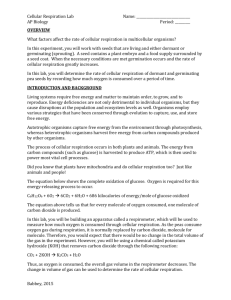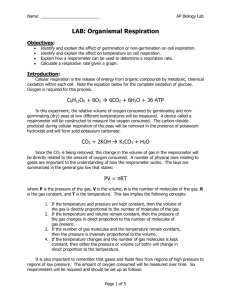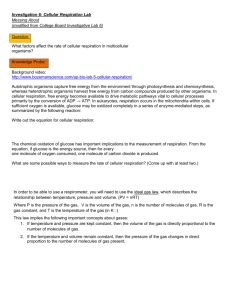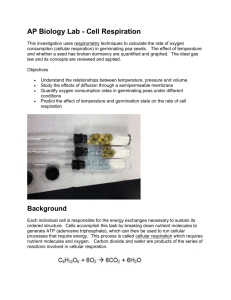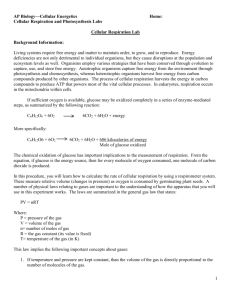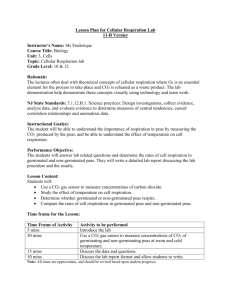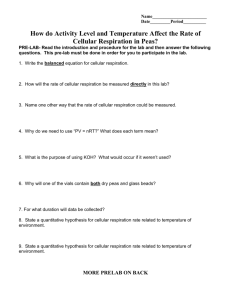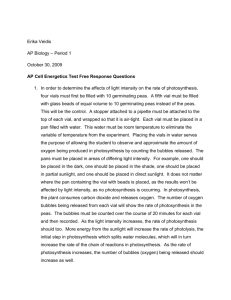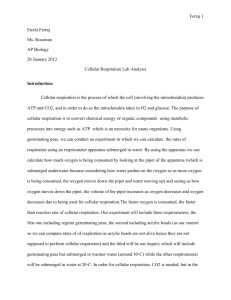File - Vishal Patel
advertisement
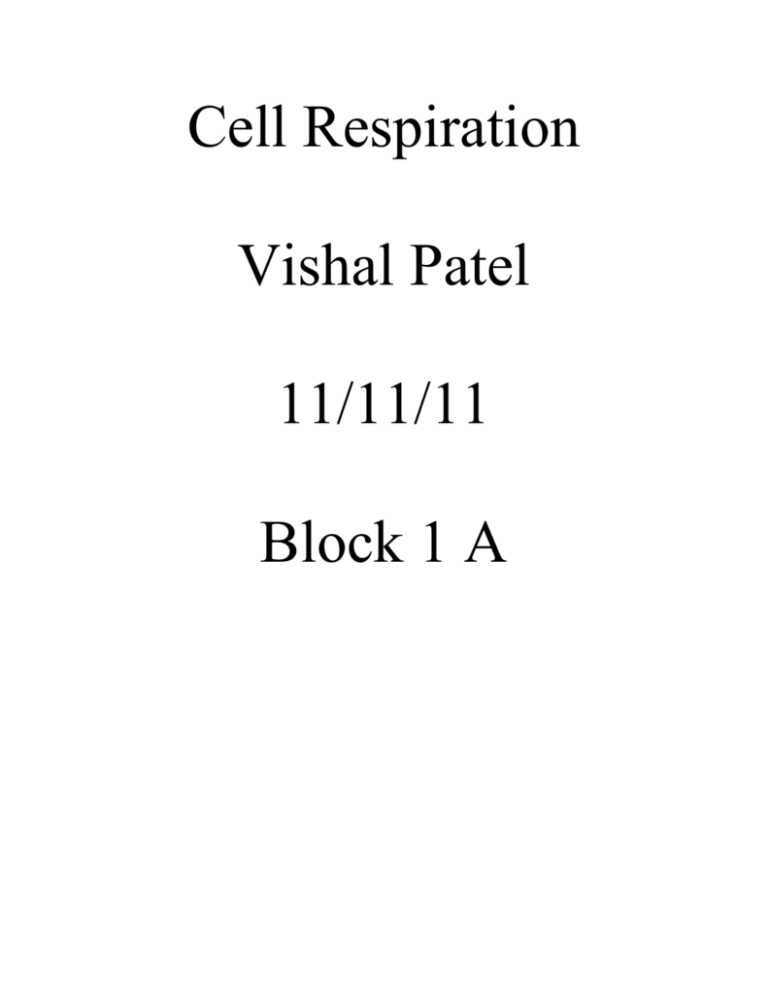
Cell Respiration Vishal Patel 11/11/11 Block 1 A Title: Cell Respiration Introduction: Many cellular processes require energy. Aerobic cellular respiration supplies energy by the oxidation of glucose. This is a complex process involving a number of enzyme-mediated reactions; however, we can summarize the process in terms of input and output products with a very simple equation: C6H1206 + 2KOH 6CO2 + 6H20 + energy. Cellular respiration occurs in most cells of both plants and animals. It takes place in the mitochondria, where energy from nutrients converts ADP to ATP. ATP is used for all cellular activities that require energy. In this laboratory, you will observe evidence for respiration in pea seeds and investigate the effect of temperature on the rate of respiration. You will use a respirometer to measure the rate of respiration of germinating and nongerminating pea seeds at two different temperatures. The respirometer consists of a vial that contains the peas and a volume of air. According to Avogadro’s law, at constant temperature and pressure one mole of any gas has the same volume of one mole of any other gas. Since one mole of carbon dioxide is released for each mole of oxygen, there is no change in the volume of gas in the respirometer. In order to disrupt the equilibrium, potassium hydroxide will be placed in the vial. Potassium hydroxide will react with carbon dioxide. As the volume of gas decreases, water will move into the pipet. The decrease in volume will be the measure of the rate of cellular respiration. Hypothesis: If I place the respirometer with only germinating peas into the water then it will consume the largest amount of oxygen and it will convert the largest amount of carbon dioxide into potassium hydroxide than the respirometers with beads and dry peas and with beads alone. Materials: The materials required for this lab are: room temperature water bath, cold water bath, container of ice, paper, water, germinating peas, nongerminating peas, glass beads, respirometers, graduated tube, absorbent and nonabsorbent cotton balls, 15% potassium hydroxide solution, dropping pipets, forceps, thermometers, stopwatch or timer, six vials, six rubber stoppers, and a calculator. Methods: There will be two water baths to buffer the respirometers against temperature change and to provide two temperatures for testing: room temperature and a colder temperature. Place a sheet of paper in the bottom of each water bath because it will make the graduated pipet easier to read. Next place a thermometer in each tray. Also this experiment requires peas and beads for testing of each temperature. In respirometer one, put 25 mL of water in your 50 mL graduated plastic tube. Drop in 25 germinating peas and determine the volume of water that is displaced. Record the volume of the 25 germinating peas and then once you’re done remove the peas and place them on a paper towel. For respirometer two, refill the graduated tube to 25 mL with water. Drop 25 dry, nongerminating peas into the graduated cylinder. Then add enough glass beads to equal the volume of the germinating peas. Remove the nongerminating peas and then remove the beads and place them on a paper towel. For respirometer 3 refill the graduated tube to 25 mL with water and add enough glass beads to equal the volume of germinating peas. Then remove those beads and place them on a paper towel. Next grab 6 respirometers, 3 for the room temperature and 3 for the cold temperature. To assemble a respirometer, place an absorbent cotton ball in the bottom of each respirometer vial. Use a dropping pipet to saturate the cotton with 2 mL of 15% KOH. Make sure the KOH does not come in contact with the skin and make sure the KOH does not touch the side of the respirometers for it can affect the peas. Place a small wad of dry, nonabsorbent cotton on top of the KOH soaked absorbent cotton. The nonabsorbent cotton will prevent the KOH solution from contacting the peas. Next place 25 germinating peas in respirometer 1, 25 dry peas and beads in respirometer 2, and place beads only in respirometer 3. Insert a stopper fitted with a calibrated pipet into each respirometer vial. If the respirometer leaks during the experiment, it will require for the experiment to be started over. Place a set of 3 respirometers in each water bath with their pipet tips resting on one lip of the tray. Wait five minutes before proceeding because it allows time for the respirometers to reach thermal equilibrium with the water. If any of the respirometers begins to fill with water, then there is a leak. After the equilibrium period is reached, immerse all respirometers in the water bath. Position the respirometers so that it is easier to the read the scales on the pipets. The paper should be under the pipets to make reading them easier. Do not put anything else into the water bath or take anything out until all readings have been completed. Allow the respirometers to equilibrate for another five minutes. Then observe the initial volume reading on the scale to the nearest 0.01 mL. Record your results into 2 tables: one for room temperature and one for cold temperature. Results: Table 1: Respiration of Peas in Room Temperature 19 0 Respirometer 1 Respirometer 1 Respirometer 3 Germinating Peas Dry Peas + Beads Beads Only V of Change Corrected V of Change Corrected V of Corrected Pipet in Change Pipet in Change Pipet Change Volume in Volume in in Volume Volume Volume 0.57 0.63 0.88 - 19 5 0.15 0.42 0.42 0.62 0.01 0.01 0.88 0.0 19 10 0.02 0.55 0.55 0.62 0.01 0.01 0.88 0.0 19 15 0.01 0.56 0.56 0.62 0.01 0.01 0.88 0.0 19 20 0.0 0.57 0.57 0.62 0.01 0.01 0.88 0.0 Temp- Time erature (min) in C Table 2: Respiration of Peas in Cold Temperature 10 0 Respirometer 1 Respirometer 1 Respirometer 3 Germinating Peas Dry Peas + Beads Beads Only V of Change Corrected V of Change Corrected V of Corrected Pipet in Change Pipet in Change Pipet Change Volume in Volume in in Volume Volume Volume 0.9 0.9 0.9 - 10 5 0.61 0.29 0.24 0.85 0.05 0 0.85 0.05 10 10 0.5 0.4 0.325 0.85 0.05 -0.025 0.825 0.075 12 15 0.425 0.475 0.4 0.875 0.025 -0.05 0.825 0.075 12 20 0.375 0.525 0.45 0.925 -0.025 -0.1 0.825 0.075 Temp- Time erature (min) in C The Rate of Respiration 0.6 0.55 Oxygen Consumed (mL) 0.5 0.45 0.4 0.35 0.3 0.25 0.2 0.15 0.1 0.05 0 1 3 5 7 -0.05 -0.1 Time (Minutes) 1. Write two hypothesis that this experiment is designed to test If I place respirometer one into the water at room temperature then the volume of the pipet will go down. If I place glass beads into a respirometer then they will not respire. 2. Using the general gas law and your experience in this lab, give the variable that had to be controlled for your data to be valid. State the controls used for each variable and any means used to correct for the influence of a variables. Some constants are the constant temperature in the water baths yielding stable readings, the unvarying volume of KOH from vial to vial leading to equal amounts of carbon dioxide consumption, identical equilibrium periods for all of the respirometers, precise time intervals between measurements, and the glass beads acting as a control for biometric pressure. 3. Which of the respirometers serves as a negative control? Explain your answer. Respirometer 3 serves as a negative control because there is nothing alive in it. The glass beads serve as a control also because they don’t respire. It was used to check the correction of preparation and to maintain equilibrium. 4. In reference to the general gas law, and assuming your control measures worked, a change to which of the variables led to the observed change in volume (Corrected change in volume in Tables 1 and 2)? Explain your answer. The observed change in volume was the result of a change in the number of gas molecules present. Both set of peas produced oxygen. The increase of the total volume is due to the increase in the amount of oxygen. 5. Using your graph and data tables, summarize your findings, comparing results from respirometers 1 and 2, and results obtained at room temperature vs. results at the colder temperature. Speculate as to the causes of any differences between the treatments. The germinating peas at cold temperature respired the most by the end of 20 minutes. Until that point, at room temperature the germinating peas respired more than the rest. The peas that were not germinated at room temperature respired much less than the ones that were germinated; however, the non-germinating peas at room temperature respired more than the nongerminating peas in cold water. Both dry and germinating peas fluctuated in which respired more, but the results showed the germinating peas clearly respired more. 6. From your graph, calculate the rate of oxygen consumption for each treatment: a. Germinating seeds at room temperature = 0.0285 mL/min b. Germinating seeds at colder temperatures = 0.02625 mL/min c. Dry seeds at room temperature = 5 x 10 -4 mL/min d. Dry seeds at colder temperatures = -0.00125 mL/min Error Analysis: Numerous errors could have occurred throughout this experiment. The seals on the respirators may not have been completely air-tight. The use of KOH pellets instead of liquid may have caused errors in the carbon dioxide absorbed. The temperature may have been slightly off in the water baths. The amounts of peas, beads, KOH, and cotton may have varied from vial to vial which would damage the results. Timing for the equilibration of the respirometers and the five-minute time intervals may have been off. It might have been somewhat difficult to read the markings on the pipettes and so errors are always likely. Mathematical inaccuracies may have taken place when filling out the table and finding the corrected difference by using the formula provided. Conclusion: The oxygen consumption in the respirometer with germinating peas was greater than that in the respirometers with nongerminating peas because the germinating peas require a larger amount of oxygen to be consumed. Respiration rate was affected by temperature. Respiration occurred at a faster rate in the respirometers in the room temperature bath. This lab showed that temperature and respiration rates are directly proportional; as temperature increases, respiration rates increase as well. In the lab, carbon dioxide made during cellular respiration was removed by the potassium hydroxide and it created potassium carbonate. It was necessary that the carbon dioxide be removed so that the change in the volume of gas in the respirometer was directly proportional to the amount of oxygen that was consumed. Also water moved toward the region with lower pressure.

